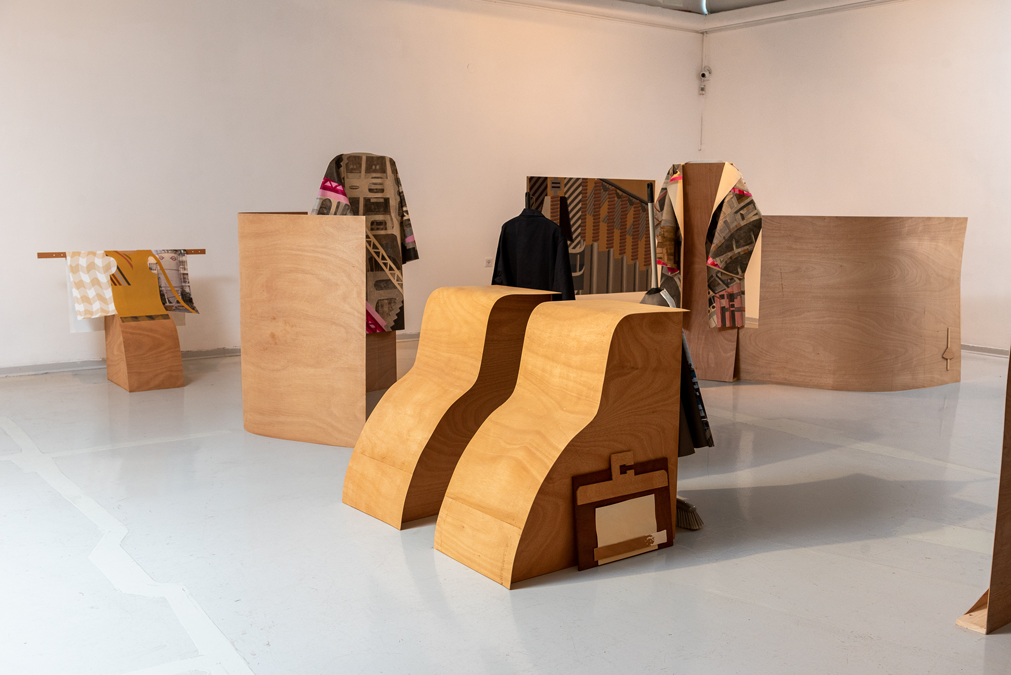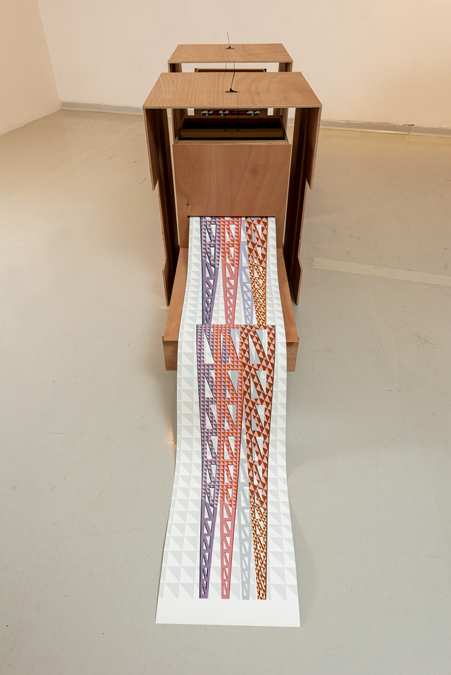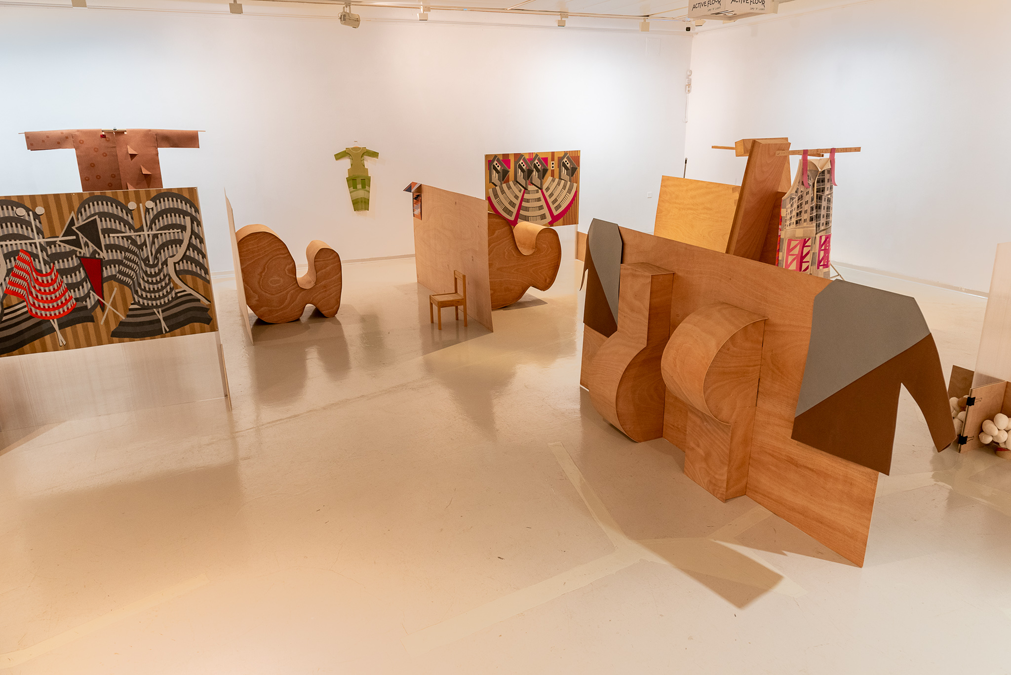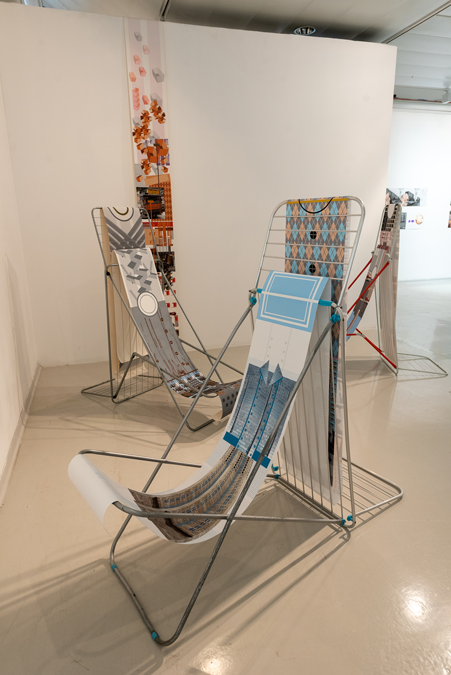-
CuratorshipAvi Ifergan
-
ArtistsAsaf Rahat
-
date20.05.23 - 30.09.23
Between the work street and a certain alley / Yitzhak Golombek and Nurit David in joint works 2022-23
Between the work street and a certain alley – Nurit David, Yitzchak Golombek
Between Haboda Street and Palonit Alley, the name of the exhibition describes a Tel Aviv urban space of streets, ongoing construction, cranes and concrete mixers whose vision is etched in Nurit David’s prints and paintings. Lahaba Street and Palonit Alley are the link between Nurit David and Yitzhak Golombek, David lived on Lahaboda Street and Golombek in the alley So-and-so. Two streets within walking distance made mutual studio visits possible in the 1980s, and in the air were peaks of Israeli art, which hid in the depths of the poverty of the material and the plywood philosophy of those days. In those meetings, between David and Golombek, an intimate system of conversations and discussions on issues of Painting and sculpture. It is assumed that questions arose about the volumetric sculpture of Yitzchak, who is trapped in a liquid tear of sadness, cubic meters of dry Israeli air, and about David’s painting, which moves between the horizontal and the vertical and raises a drone’s view over gardens and spaces. And the relief paintings from matches, paintings that are at the same time, horizontal as well as vertical in the form of a horizontal walk of feet with matches on a surface between the words “laughter, juice and shadow” David’s fake Chinese (in the exhibition, I was born Chinese, 2006), and in the current exhibition the echo and a deep emotional look at Japanese culture. Forty years of conversations were characterized by a layered artistic relationship, with each one working separately and presenting exhibitions separately, and here for the first time the mystical connection was created, which has A lot of sex that unites and less that separates. From the first reading, the name of the exhibition encodes a hidden secret, and arouses curiosity as to what happened between these streets of Tel Aviv. A little of this curiosity peels off and unfolds in the exhibition. But the hidden texts of deep conversations about art will remain in the minds of Nurit and Yitzchak. The rare meeting between the two artists whose discourse on art was heated in rooms and now they apply that hidden discourse in a joint exhibition, which invites us on a rare journey of observation into the combination of Nurit’s painting and Yitzhak’s sculpture. At first glance, the exhibition is experienced as one total work, but the more you look and walk between the rows, the more you see two visual languages that unite into one work. One layered vision from which shines the depth of the conversation that takes place between Nurit and Yitzchak. The exhibition space is divided into parallel strips that simulate a space of open offices with low walls, or of parallel streets with housing lines. The vertical plywood panels that serve as a back for Yitzhak’s plywood sculptures form pedestals for Nurit’s canvas paintings. The minimalist plywood panels, some of which are curved and bear the painted kimono of a light bulb on a candlestick, become a physical discourse of skin that touches skin, the skin of the plywood to the skin of the candlestick. The waxwork kimono is covered in architectural drawings of Tel Aviv, which is in an ongoing construction binge. The connection between a garment and architecture and between a bride and architecture moves like a pendulum between these images which are loaded with meaning in the depths of David’s art. The garment is the second skin that separates us from the world and the existential space, and the architecture and structure is the second skin, the other to the body sheltered within it. There is one view of the exhibition in which the presence of the panels is dominant with a minimalist modernist look, and when you reverse the direction of the look, a different look of charged images from the lexicon of Nurit and Yitzchak is revealed. Yitzhak’s wave of water that extinguishes or fails to extinguish the fire generated by the matches of a light bulb. A meeting of fire and water. Yitzhak sculpts abstract sculptural forms in this exhibition and gives up his inventory of images, drops/tears, teeth, a comb and the missing keys that will open a door to the winding labyrinth that Norit and Yitzhak created. To walk here, as in a foreign city, as in a dream. The visitor becomes a “wanderer”, no In Walter Benjamin’s Berlin, perhaps in Norit’s China or Japan, or between Yitzhak and Norit’s housing estates. Between the rows of plywood panels the heroism and the crucifixion are revealed. The exhibition hides a secret, who is crucified and who is the hero, who is the crusader or who is the shooter? The answer may be borne in the spirit of the digital collages where the visual texts of four decades of deep conversations between Yitzhak and Norit appear.
[1] From a painting; Nurit David, Father II (laughter, juice, shadow) 1985
-
CuratorshipAvi Ifergan
-
date20.05.23 - 30.09.23
-
ArtistsAsaf Rahat







